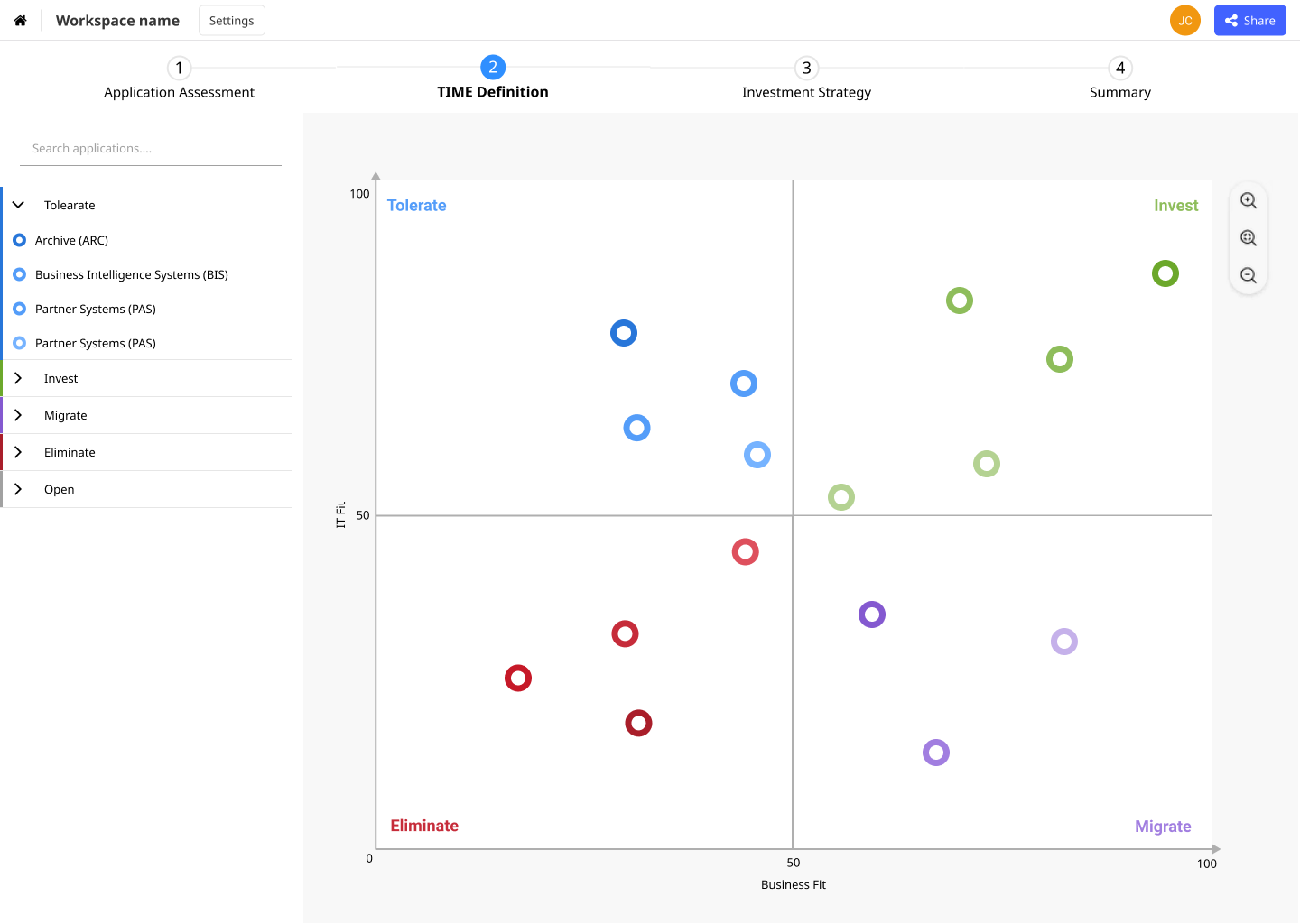Introduction
In today’s fast-evolving digital economy, transformation has become a fundamental part of every organization’s operating model. Business change is constant and inevitable, but when poorly managed, it has the potential of causing organizational stress, fragmentation in your enterprise architecture, and lead to unnecessary and costly work.
That’s why creating a “digital twin” of the organization – which outlines your IT architecture, application portfolio structure and helps you understand the impact of changes across the enterprise – can be one of the most pivotal components in the success of your transformation.
Read on and find out how you can leverage your applications portfolio to pragmatically evaluate your investment decisions and steer changes in your organization in a targeted and strategic manner.
Why is defining an investment strategy important?

All organizations have their short-term and long-term objectives. It’s ultimately what defines a company’s direction, drives the business forward and allows it to carry out its mission and vision. Investment strategy is the game plan that helps companies orchestrate resources and structure growth initiatives to meet their goals in the most efficient way.
So, what does this mean in the Application Portfolio Management context? With the ever-growing number of applications in the organization, it’s becoming increasingly hard to keep track of the applications you have, the purpose they serve, their usage, business value, etc. – leading to potential duplicate functions and redundancies.
Having a solid application investment strategy ensures that your portfolio adequately and efficiently supports your evolving business and technical needs.
By performing regular assessments of your portfolio, you are able to understand how well your applications contribute to the organization’s goals, make data-based decisions to streamline your stack and define a strategy for each application that effectively enables your transformation.
Do you feel like your existing application portfolio does not support your change initiatives in the best possible manner? Do you want to evaluate some new applications and see how well they would fit before adopting them? Or did you simply introduce a great number of applications over time and feel like some of them require re-evaluation?
Then be sure to keep on reading and discover our top 5 recommended steps to successfully assessing your applications and defining a robust investment strategy!
How to assess your portfolio and define your APM investment strategy?
Step 1 – Select the applications you want to evaluate (Define the scope)
Dive into your portfolio and categorize your applications into groups based on different criteria, such as: application functions, the capabilities they support, and alike. Together with your business experts, consider a group of applications relevant for one specific transformation initiative. If there are also new applications that you are considering in addition, add them to the appropriate set as well.
Step 2 – Assess the fitness level
Define a set of questions that will help you assess the fitness level of each application. For instance, in order to score the business fitness of your application portfolio, ask yourself the following questions:
- To which extent does this application support our business architecture?
- Does it help us gain a competitive advantage?
- How seriously would a failure of this application affect our organization’s business?
When doing this, be sure to also take the other fitness scores into consideration, such as the cost or technological fitness. Discuss the best assessment questions within your team and try to answer them yourselves, alternatively send out a survey to your application experts.
Step 3 – Propose an investment strategy for your application portfolio
Based on your assessments, the next step would be the development of your application portfolio investment strategy. Gartner® recommends the TIME model for doing so. The TIME model is a 2×2 quadrant showcasing the different investment strategy possibilities – based on the ratio of the applications’ technical quality and the business value they bring to the organization. The four proposed strategies are:
Tolerate
- Positioning: Low business value, but high technical quality
- Investment strategy: Keep maintaining these applications, as they serve their purpose without incurring too much cost, don’t invest in them but also don’t commit resources trying to improve them
Invest
- Positioning: High business value and high technical quality
- Investment strategy: Keep investing in these applications to get even better returns or reduce more costs
Migrate
- Positioning: High business value, but low technical quality
- Investment Strategy: Consider migrating to applications that provide similar benefits and functions, but are better supported by your existing technology architecture
Eliminate
- Positioning: Low business value and low technical quality
- Investment Strategy: Decommission these applications, as they are of little (if any) benefit to the organization, but cause (significant) cost and/or technological incompatibility

Example of a TIME assessment in the ADOIT EA suite
Find out more about Gartner’s® TIME model here.
Step 4 – Learn from your previous decisions
While defining the investment strategy for your application portfolio, don’t let your empirical knowledge go to waste. Therefore, take your previous decisions into account! What have you learned so far that can influence your strategy? Or even better: What does the industry standard have to say about it?
Hint:
Step 5 – Derive requirements based on your overall results
Once you have decided on your investment strategy, think about the next steps you need to take in order to fulfill it. Derive requirements for each respective application. For instance, if you’ve decided that you should further invest in an application, you should probably do some of the following steps to realize this:
- Enhance: Upgrade application to a newer version.
- Re-platform: Move application to a more modern technical environment.
- Remediate: Refactor application to further improve the integration capabilities.
Summary and next steps
Application assessment and definition of the investment strategy for your portfolio enables you to plan the next steps towards achieving your business goals. By being aware of your portfolio’s strengths and weaknesses, as well as being determined to follow a certain strategic path, you set out a solid foundation for organizing and guiding your transformation initiatives, i.e. what needs to be done, when, who needs to be doing it and how.
To learn more about Application Portfolio Management and how you can leverage your applications to achieve business objectives, check out our free e-APM learning.
And in case you are in the process of defining your application investment strategy and would like some advice on your specific use case – be sure to fill out the contact form below and have a quick chat with our APM experts. We would love to support your transformation journey!
Get our weekly updates.
Never miss the freshest content.







